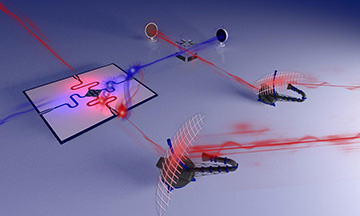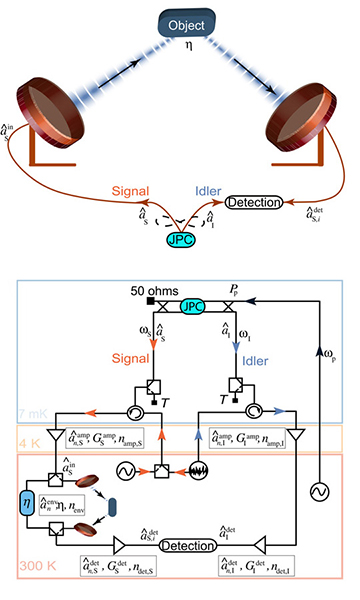
A multinational team of scientists has prototyped a “quantum radar” system that takes quantum illumination to the microwave domain. [Image: © IST Austria/Philip Krantz]
Quantum approaches to illumination and sensing are a natural fit at optical and telecom wavelengths. But the situation has been different in the microwave band, where scientists have a less extensive suite of quantum tools to call upon. That’s unfortunate, a quantum view of microwaves offers tantalizing opportunities for improving on the sensitivity of classical systems in some application areas.
A multinational research team has now put on the table a proof of concept for one such application—a sort of quantum radar (Sci. Adv., doi: 10.1126/sciadv.abb0451). The setup, according to the team, could enhance ordinary low-power radar detection in noisy environments, expanding prospects in areas such as noninvasive bioimaging and security.
Quantum illumination
The work of the multinational team, which includes researchers from the Institute of Science and Technology (IST) Austria, the Massachusetts Institute of Technology (USA), the University of York (U.K.) and the University of Camerino (Italy), is rooted in so-called quantum illumination (QI)—a concept theoretically articulated in a 2008 paper by Seth Lloyd, and extensively developed since then in the optical domain.
The principles of QI are relatively simple. It begins with the creation of two beams, signal and idler, consisting of quantum mechanically entangled photons. The signal beam is sent out to reflect off of an object in a noisy environment and return to a detector, while the idler beam, true to its name, bides its time in a low-noise environment before being detected. The reflected beam, including both signal photons reflected from the object being sensed and environmental noise, is then interfered with the idler beam.
While strict entanglement between the signal and idler beams is lost when the signal beam makes its round trip through a noisy environment, enough quantum correlation with the idler photons remains to distinguish the reflected signal photons unambiguously from the background noise. This, in turn, allows the signal from the reflecting object—which, in a strictly classical scheme, might be swamped by the noise—to be picked out and imaged.
Going microwave with QI
Such a scheme could be a natural fit in the microwave domain, and particularly in low-power radar applications, to identify low-reflectivity objects that in classical radar are swamped by thermal noise. Members of the research team behind the current work theoretically fleshed out such a microwave QI scheme in 2015. Now, the team has put together a prototype of a working system.

Schematic (top) and circuit diagram (bottom) of proof-of-concept system, which includes a superconducting, refrigerated Josephson parametric converter (JPC) to create entangled signal and idler photons. [Image: S. Barzanjeh et al., Sci. Adv., doi: 10.1126/sciadv.abb0451 (2019); CC BY 4.0]
The system begins with a Josephson parametric converter (JPC), inside a dilution refrigerator, which creates entangled microwave photons at a frigid temperature only a few thousandths of a degree above absolute zero. The microwave mode consisting of the signal photons is then amplified and sent through a thermally noisy, room-temperature environment to probe a target, which reflects the beam back to a quantum-optimized, digital phase-sensitive receiver. The post-processing of the digital data pulls out the quantum annihilation operators of the reflected signal and idler modes, allowing the correlations between the modes to be measured and compared with the background noise.
Few photons required?
In experiments with the proof-of-concept system, the team found that, even though entanglement was indeed broken, the remnant correlations between the beam annihilation operators was sufficient to distinguish the reflected photons from the background noise. That, in turn, allowed the QI system to beat the signal-to-noise ratio of purely classical object detection in the room-temperature test.
Further, the system seems to work best at low photon numbers (less than one mean photon per mode). In the researchers’ opinion, that characteristic suggests that their microwave QI setup could have particular application in low-power, low-photon-number applications—such as noninvasive biomedical imaging and short-range radar for security—in which bright thermal noise can wreak particular havoc for all-classical detection.
Theory and practice
Getting to those applications, the team acknowledges, will require refining the system components and leverage new tools such as microwave single-photon detectors. “The main message behind our research is that ‘quantum radar’ or quantum microwave illumination is not only possible in theory but also in practice,” said lead author Shabir Barzanjeh, now with the University of Calgary, Canada, in a press release accompanying the work.
Team leader Johannes Fink of IST Austria, where Barzanjeh was a postdoc when the work was done, added that this initial result was curiosity driven, and made possible by bringing together the talents of theoretical and experimental physicists. “But to show an advantage in practical situations,” said Fink, “we will also need the help of experienced electrical engineers, and there still remains a lot of work to be done in order to make our result applicable to real-world detection tasks.”
